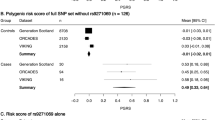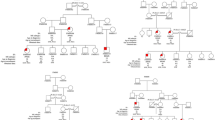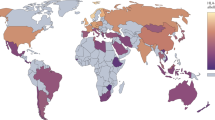Abstract
A total of 267 families with two or more siblings with multiple sclerosis (MS) were genotyped with 14 restriction fragment length polymorphisms at the TCR β locus. A nonparametric linkage analysis of the data showed no evidence for linkage to this locus (mlod=0.11). No significant allelic or haplotype transmissions were observed in the total sample of 565 patients. After stratification for the presence of HLA DRB1*15, an association was observed between the BV25S1*1-BV26S1*1-BV2S1*1 haplotype and MS (P=0.00089). This was not significant upon correction for multiple comparisons. It was also not significant when the haplotype frequency in affected individuals was compared to a normal control sample (P=0.77). Furthermore, the associated haplotype was followed-up in an independent sample of 97 nuclear families with a single DRB1*15-positive child with MS. The BV25S1*1-BV26S1*1-BV2S1*1 haplotype did not show significant evidence for transmission distortion but the same trend was seen (P=0.21). There were no significant associations observed in the DRB1*15-negative patients and no detectable difference was seen in the DRB1*15-positive BV25S1*1-BV26S1*1-BV2S1*1 association when comparing different subgroups based on clinical course of MS. These results show no evidence for linkage and fail to establish an association between MS susceptibility and the TCR β locus.
This is a preview of subscription content, access via your institution
Access options
Subscribe to this journal
Receive 6 digital issues and online access to articles
$119.00 per year
only $19.83 per issue
Buy this article
- Purchase on Springer Link
- Instant access to full article PDF
Prices may be subject to local taxes which are calculated during checkout

Similar content being viewed by others
References
Oksenberg JR, Stuart S, Begovich AB et al. Limited heterogeneity of rearranged T-cell receptor V alpha transcripts in brains of multiple sclerosis patients. Nature 1990; 345: 344–346.
Hashimoto LL, Mak TW, Ebers GC . T cell receptor alpha chain polymorphisms in multiple sclerosis. J Neuroimmunol 1992; 40: 41–48.
Hillert J, Leng C, Olerup O . T-cell receptor alpha chain germline gene polymorphisms in multiple sclerosis. Neurology 1992; 42: 80–84.
Seboun E, Robinson MA, Doolittle TH, Ciulla TA, Kindt TJ, Hauser SL . A susceptibility locus for multiple sclerosis is linked to the T cell receptor beta chain complex. Cell 1989; 57: 1095–1100.
Haines J, Pericak-Vance M, Seboun E, Hauser S, the Multiple Sclerosis Genetics Group. A complete genomic screen for multiple sclerosis underscores a role for the major histocompatability complex. Nat Genet 1996; 13: 469–471.
Lynch SG, Rose JW, Petajan JH, Stauffer D, Kamerath C, Leppert M . Discordance of T cell receptor in familial multiple sclerosis. Ann Neurol 1991; 30: 402–410.
Sawcer S, Jones H, Feakes R et al. A genome screen in multiple sclerosis reveals susceptibility loci on chromosome 6p21 and 17q22. Nat Genet 1996; 13: 464–468.
Ebers G, Kukay K, Bulman D et al. A full genome search in multiple sclerosis. Nat Genet 1996; 13: 472–476.
Beall SS, Concannon P, Charmley P et al. The germline repertoire of T cell receptor beta-chain genes in patients with chronic progressive multiple sclerosis. J Neuroimmunol 1989; 1: 59–66.
Beall S, Biddison W, McFarlin D, McFarland H, Hood L . Susceptibility for multiple sclerosis is determined, in part, by inheritance of a 175 kb region of the TCR Vb chain locus and the HLA class II genes. J Neuroimmunol 1993; 45: 53–60.
Buhler M, Bennets BH, Heard RNS, Stewart G . T cell receptor β chain genotyping in Australian relapsing–remitting multiple sclerosis patients. Mult Scler 2000; 6: 140–147.
Briant L, Avoustin P, Clayton J, McDermott M, Clanet M, Cambon-Thomsen A, the French Group on Multiple Sclerosis. Multiple Sclerosis susceptibility: population and twin study of polymorphisms in the T-cell receptor β and γ genes region. Autoimmunity 1993; 15: 67–73.
Martinez-Naves E, Victoria-Gutierrez M, Uria DF, Lopez-Larrea C . The germline repertoire of T cell receptor β-chain genes in multiple sclerosis patients from Spain. J Neuroimmunol 1993; 47: 53–60.
Epplen C, Jackel S, Santos E et al. Genetic predisposition to multiple sclerosis as revealed by immunoprinting. Neurology 1997; 41: 341–352.
Hockertz M, Paty D, Beall S . Susceptibility to relapsing-progressive multiple sclerosis is associated with inheritance of genes linked to the variable region of the TCR β locus: use of the affected family-based controls. Am J Hum Genet 1998; 62: 373–385.
Wei S, Charmley P, Birchfield R, Concanon P . Human T cell receptor Vb gene polymorphism and multiple sclerosis. Am J Hum Genet 1995; 56: 963–969.
Vandevyver C, Buyse I, Philippaerts L et al. HLA and T-cell receptor polymorphism in Belgium multiple sclerosis patients: no evidence for disease association with the T-cell receptor. J Neuroimmunol 1994; 52: 25–32.
Hillert J, Leng C, Olerup O . No association with germline T cell receptor beta chain alleles or haplotypes in Swedish patients with multiple sclerosis. J Neuroimmunol 1991; 31: 141–147.
Fugger L, Sandberg-Wollheim M, Morling N, Ryder LP, Svejgaard A . The germline repertoire of T-cell receptor β chain genes in patients with relapsing/remitting multiple sclerosis or optic neuritis. Immunogenetics 1990; 31: 278–280.
Droogan AG, Kirk CW, Hawkins SA, McMillan SA, Nevin NC, Graham CA . T-cell receptor alpha, beta, gamma, and delta chain association microsatellites show no association with multiple sclerosis. Neurology 1996; 47: 1049–1053.
Wansen K, Pastinen T, Kuokkanen S et al. Immune system genes in multiple sclerosis: genetic associations and linkage analyses on TCR β, IGH, IFN-γ and IL-1ra/Il-1 β loci. J Neuroimmunol 1997; 79: 29–36.
Ebers GC, Sadovnick AD . Association studies in multiple sclerosis. J Neuroimmunol 1994; 53: 117–122.
Colhoun HM, McKeigue PM, Davie-Smith G . Problems of reporting genetic associations with complex outcomes. Lancet 2003; 361: 865–872.
Lange HLE, Jacobsen H, Ikemizu S et al. A functional and structural basis for TCR cross-reactivity in multiple sclerosis. Nat Genet 2002; 3: 940–943.
Wood NW, Sawcer SJ, Kellar-Wood HF et al. The T cell receptor B locus and susceptibility to multiple sclerosis. Neurology 1995; 45: 1859–1869.
Xu C, Dai Y, Lorentzen J, Dahlman I, Olsson T, Hillert J . Linkage analysis in multiple sclerosis of chromosomal regions syntenic to experimental autoimmune disease loci. Eur J Hum Genet 2001; 9: 458–463.
Poser CM, Paty D, Scheinberg L et al. New diagnostic criteria for multiple sclerosis: guidelines for research protocols. Ann Neurol 1983; 13: 227–231.
Wei S, Charmley P, Robinson MA, Concannon P . The extent of the human germline T-cell receptor V beta gene segment repertoire. Immunogenetics 1994; 40: 27–36.
Olerup O, Zetterquist H . HLA-DR typing by PCR amplification with sequence-specific primers (PCR-SSP) in 2 hours: an alternative to serological DR typing in clinical practice including donor–recipient matching in cadaveric transplantation. Tissue Antigens 1992; 39: 225–235.
Spielman RS, McGinnis RE, Ewens WJ . Transmission test for linkage disequilibrium: the insulin gene region and insulin-dependent diabetes mellitus (IDDM). Am J Hum Genet 1993; 52: 506–516.
Kruglyak L, Daly MJ, Reeve-Daly MP, Lander ES . Parametric and nonparametric linkage analysis: a unified multipoint approach. Am J Hum Genet 1996; 58: 1347–1363.
Stephens M, Smith NJ, Donnelly P . A new statistical method for haplotype reconstruction from population data. Am J Hum Genet 2001; 68: 978–989.
Stephens M, Donnelly P . A comparison of bayesian methods for haplotype reconstruction from population genotype data. Am J Hum Genet 2003; 73: 1162–1169.
Zar JH . Biostatistical Analysis. Prentice-Hall: New Jersey, 1984.
Abecasis GR, Cookson WO . GOLD—graphical overview of linkage disequilibrium. Bioinformatics 2000; 16: 182–183.
Acknowledgements
Funding for the Canadian Collaborative Project on Genetic Susceptibility to MS is through the MS Society of Canada Scientific Research Foundations. The MS Society of Canada has funded studentships to David Dyment and Cristen Willer. Dr Sadovnick is a Michael Smith Foundation for Health Research Distinguished Scholar.
Author information
Authors and Affiliations
Consortia
Corresponding author
Additional information
Supplementary information accompanies the paper on the Genes and Immunity's website (http://www.nature.com/gene).
Supplementary information
Rights and permissions
About this article
Cite this article
Dyment, D., Steckley, J., Morrison, K. et al. TCR β polymorphisms and multiple sclerosis. Genes Immun 5, 337–342 (2004). https://doi.org/10.1038/sj.gene.6364091
Received:
Revised:
Accepted:
Published:
Issue Date:
DOI: https://doi.org/10.1038/sj.gene.6364091
Keywords
This article is cited by
-
Revisiting the T-cell receptor alpha/delta locus and possible associations with multiple sclerosis
Genes & Immunity (2011)
-
Three allele combinations associated with Multiple Sclerosis
BMC Medical Genetics (2006)



